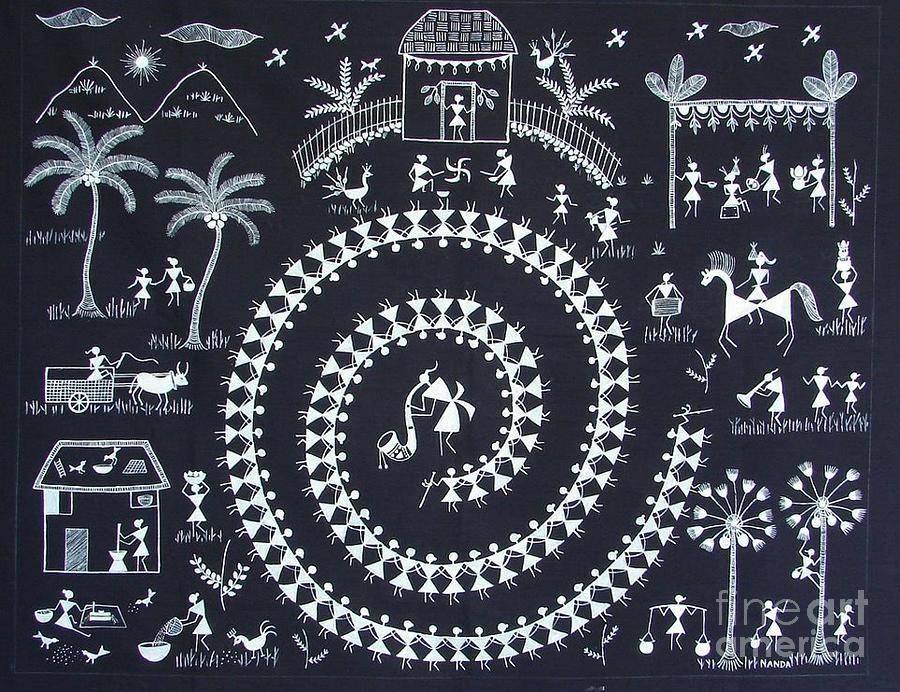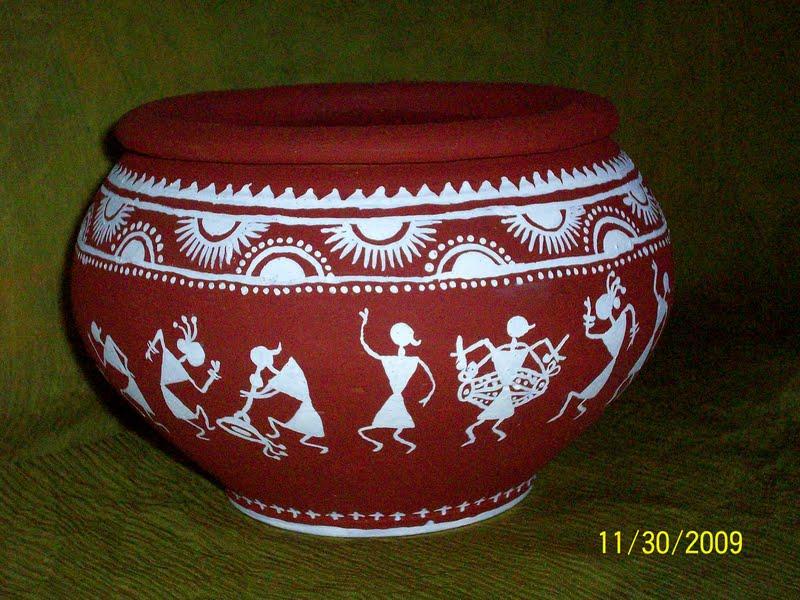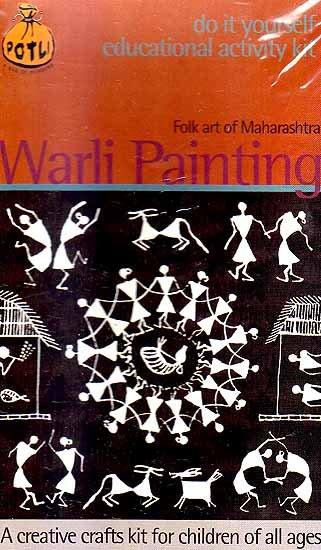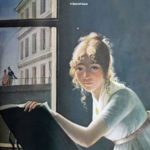When one mentions ‘Warli!’, a vision of a stick figure with geometric designs is lit up in the mind with a black background and white etching of figures and simple village landscapes.

The Warli Dance
This art form dates back to 3000 B.C and originates from coastal and border areas of Gujrat and Maharashtra.
Warli was traditionally used to paint walls of houses with a mud base and the figurines were created through chalk or rice paste upon it.
Villagers used it to express their happiness, celebration, festivals and marriage occasions as well. Some also expressed the village lifestyle and the scenic beauty of nature.

A village day!
Some even have depicted the daily chores of the village women and their livelihood.

Busy Ladies!
These paintings can be seen on the walls of a few schools today which aim to relive the era and enigma of the art and teach the students to preserve their heritage in the same manner.
Warli art is also being brought alive by some of the fashion designers and also a few home décor brands in a modernized version of its traditional version.
Artists aim to recreate such art and maintain its vintage. Whereas art collectors are keen on having every version of this form of tribal art.
Warli is also being taught to students at schools and art colleges for encouraging the preservation of ancient art and heritage.
‘This was the first lesson I learnt before working on my Fresco!’, exclaims a final year student of architecture.

Antique pot
Traditionally the raw materials being used for Warli were mud plaster, rice paste with water and gum and a chewed bamboo stick which would act as a paintbrush.
But today students use chart papers, paints in water-colour or acrylic form and a 0-1 numbered paintbrush to create this piece.
There are also some sketchers who have created modern versions of Warli through ink or blot pens.
The rustic and antique charm of this art has attracted famous designers like Anita Dongre and James Ferreira and has inspired them to include it in their collections.
Today in the era of gadgets, expressions are communicated through emoticons. But tribal art has expressed all kinds of feelings through the famous Warli!
Domestic and international hotel lobbies and rooms are flaunting this form of tribal art and making it famous.
This tribal art is also viral in metros like Bengaluru, Chennai and Delhi.

Hotel lobby
Warli is charming everyone with its geometrical patterns, figurines and flowers.
Today this tribal art can be evident in merchandise like bags and sarees and mostly sold in government regulated art emporiums as well as the retail market.
This form of art also is showcased in the lobbies of Mumbai’s Domestic as well as International airports.
It has been quoted as the simplest form of art forms though it does not make any sense to the layman’s eye.
It also has been quoted as the simplest form of stick-figure sketch by art professors.

Warli modern sketch
This tribal form of part is virally being appreciated by art lovers, who in turn are using the design in their day-to- day activities in the form of a coffee coaster or a funky t-shirt or even a Satya Paul’s chiffon saree for instance. Warli art is hugely becoming a part of the back- to- the roots movement wherein all traditional form of art are being widely used in daily lifestyle activities.
Merchandise like a large and swanky tea mug was found on the shelves of an ARCHIES’s store by an art collector along with fancy bookmarks on the billing counter.
Even the greeting cards made and hosted by organizations like CRY and UNICEF have this tribal print on them, which forms an evidence that our art forms have been accepted globally too.
In a school event in Nashik, students were all gifted with Warli Art Kits which comprised of a black colored cloth piece with the design’s blueprint already on it, with a paintbrush and the white acrylic paint for the finish.
‘Kids were so tempted that they could not wait to inaugurate their kits after getting home and requested their art teachers to explore their kits in their art class!’
Similarly an Art collector’s mother could not decide whether to discard some of the old collectibles or her son!
Art students are learning this art and replicating it in a modernized traditional manner, wherein the traditional red and ochre background has been replaced with orange, black, navy blue, white and many other shades which the human mind may not even think of.

The art kit
Warli print kurtis had become quite a rage among college students in 2011, it was evident that girls used to compete with each other for flaunting the best warli design in the college.
In another tribal art exhibition, people embraced umbrellas and vintage clocks with this rustic print.
Warli has reached almost everywhere, even where water cannot flow technically.
One of the small scale entrepreneurs in Navi Mumbai has made a living by manufacturing handmade bags and organisers with this tribal print on it, with backgrounds available in navy blue, balack, red and mustard yellow.
Even stationery items like pens and diaries are in huge demand by the public, quoted another stationery shop owner based in Pune. He also cited that most of his revenue during the year is being made through the sales of this warli items only.
In an effort to keep this art form alive, we have people and artists who have build Gowardhan Eco Village in Thane of Mumbai through the usage mud and cow dung and painting the walls with this tribal art.
Also Ganjad of Palghar at Navi Mumbai got adopted by a group of Japanese artists for restoring the art through the usage of bamboo sticks, mud and cowdung.
Dahanu also has seen a similar view of development in restoring this form of art.



What do you think?